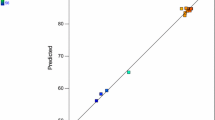Abstract
The removal rate of Cr6+ has been explored by the optimized removal conditions. Five Cr-resistant strains were isolated from chromium-contained soil. The most efficient strain S1 was identified as Bacillus subtilis strain SZMC 6179J through 16S rDNA. Response surface methodology (RSM) was used to investigate the effects of four independent variables, including initial pH, initial Cr6+ concentration (mg/L), time (h) and inoculation percentage (%). RSM revealed that when pH was 5.02, time was 24.0 h, inoculation percentage was 4.64% (v/v) and initial concentration of Cr6+ was 55.0 mg/L, the optimal condition was obtained. Under the optimum conditions, the actual response values for Bacillus subtilis strain SZMC 6179J was 93.50%. The pH was the most significant factor towards removal rate of Cr6+. The result showed that the removal mechanism of Cr6+ by Bacillus subtilis strain SZMC 6179J was reduction under normal conditions. The removal mechanism of Cr6+ by Bacillus subtilis strain SZMC 6179J was adsorption under adverse conditions.


Similar content being viewed by others
References
Gupta VK, Nayak A, Agarwal S (2015) Bioadsorbents for remediation of heavy metals: current status and their future prospects. Environ Eng Res 20:1–18. https://doi.org/10.4491/eer.2015.018
Ping L, Zhang J, Wang J (2015) Heavy metal(loid) pollution in mine wastes of a Carlin-type gold mine in southwestern Guizhou, China and its environmental impacts. Chin J Geochem 34:311–319. https://doi.org/10.1007/s11631-015-0055-5
Ran X, Shuang W, Li R (2017) Soil heavy metal contamination and health risks associated with artisanal gold mining in Tongguan, Shaanxi, China. Ecotox Environ Safe 141:17–24. https://doi.org/10.1016/j.ecoenv.2017.03.002
Sivapathasekaran C, Mukherjee S, Sen R (2010) Optimization of a marine medium for augmented biosurfactant production. Int J Chem React Eng 8:1–10. https://doi.org/10.2202/1542-6580.2231
Hausladen DM, Alexander-Ozinskas A, Mcclain CN (2018) Hexavalent chromium sources and distribution in California groundwater. Environ Sci Technol 159:782–792. https://doi.org/10.1021/acs.est.7b06627
Zhou X, Lv B, Zhou Z (2015) Evaluation of highly active nanoscale zero-valent iron coupled with ultrasound for chromium (VI) removal. Chem Eng J 281:155–163. https://doi.org/10.1016/j.cej.2015.06.089
Sousa M, Melo VMM, Rodrigues S, Sant’ana HB, Gonçalves LRB (2012) Screening of biosurfactant-producing Bacillus strains using glycerol from the biodiesel synthesis as main carbon source. Bioproc Biosyst Eng 35:897–906. https://doi.org/10.1007/s00449-011-0674-0
Habiba U, Afifi AM, Salleh A (2017) Chitosan/(polyvinyl alcohol)/zeolite electrospun composite nanofibrous membrane for adsorption of Cr6+, Fe3+ and Ni2+. J Hazard Mater 322:182–194. https://doi.org/10.1016/j.jhazmat.2016.06.028
Tamura K, Peterson D, Peterson N, Stecher G, Nei M, Kumar S (2011) MEGA5: molecular evolutionary genetics analysis using maximum likelihood, evolutionary distance, and maximum parsimony methods. Mol Biol Evol 28:2731–2739. https://doi.org/10.1093/molbev/msr121
Pandey PK, Sharma SK (2017) Removal of Cr(VI) and Pb(II) from Wastewater by zeolite NaX in fixed bed column. Water Conserv Sci Eng 2:61–65. https://doi.org/10.1007/s41101-017-0026-2
Liu JH, Chen YT, Xu RD, Jia YP (2013) Screening and evaluation of biosurfactant-producing strains isolated from oilfield wastewater. Indian J Microbiol 53:168–174. https://doi.org/10.1007/s12088-013-0379-y
Untea I, Tudorache E, Neagu V (2002) Cr(VI)-containing wastewater treatment by means of ion exchange on weak- and strong-base anion exchangers. J Appl Polym Sci 86:2093–2098. https://doi.org/10.1002/app.11175
Ahmadi R, Rezaee A, Anvari M (2016) Optimization of Cr(VI) removal by sulfate-reducing bacteria using response surface methodology. Desalin Water Treat 57:1–7. https://doi.org/10.1080/19443994.2015.1041055
Yang J, He M, Wang G (2009) Removal of toxic chromate using free and immobilized Cr(VI)-reducing bacterial cells of Intrasporangium sp. Q5-1. World J Microb Biot 25:1579–1587. https://doi.org/10.1007/s11274-009-0047-x
Aravindhan R, Fathima A, Selvamurugan M (2012) Adsorption, desorption, and kinetic study on Cr(III) removal from aqueous solution using Bacillus subtilis biomass. Clean Technol Environ 14:727–735. https://doi.org/10.1007/s10098-011-0440-7
Ren J, Li Y, Zhang Y (2015) A Bacillus subtilis strain can reduce hexavalent chromium to trivalent and an nfrA gene is involved. Int Biodeter Biodegr 97:90–96. https://doi.org/10.1016/j.ibiod.2014.10.017
Susilowati R, Sabdono A, Widowati I (2015) Isolation and characterization of bacteria associated with brown algae Sargassum spp. from Panjang island and their antibacterial activities. Procedia Environ Sci 23:240–246. https://doi.org/10.1016/j.proenv.2015.01.036
Rehman A, Zahoor A, Muneer B (2008) Chromium tolerance and reduction potential of a Bacillussp.ev3 isolated from metal contaminated wastewater. B Environ Contam Tox 81:25–29. https://doi.org/10.1007/s00128-008-9442-5
Jabasingh SA, Pavithra G (2010) Response surface approach for the biosorption of Cr6+ ions by Mucor racemosus. Clean-Soil Air Water 38:492–499. https://doi.org/10.1002/clen.200900270
Xiao W, Ye X, Yang X et al (2017) Isolation and characterization of chromium (VI)-reducing Bacillus sp. FY1 and Arthrobacter sp. WZ2 and their bioremediation potential. Bioremediat J 21:1–9. https://doi.org/10.1080/10889868.2017.1282939
Yang K, Zhang J, Yang T (2016) Investigation of equilibrium and kinetics of Cr(VI) adsorption by dried Bacillus cereus using response surface methodology. Water Sci Technol 73:617–627. https://doi.org/10.2166/wst.2015.522
Xu F, Teng M, Liu S (2014) Bioreduction of Cr(VI) by Bacillus sp. QH-1 isolated from soil under chromium-containing slag heap in high altitude area. Ann Microbiol 64:1073–1080. https://doi.org/10.1007/s13213-013-0746-2
Batool R, Qurrat UAK, Naeem A (2014) Comparative study of Cr(VI) removal by Exiguobacterium sp. in free and immobilized forms. Bioremediat J 18:317–327. https://doi.org/10.1080/10889868.2014.938722
Zheng Z, Li YB, Zhang XW (2015) A Bacillus subtilis strain can reduce hexavalent chromium to trivalent and an nfrA gene is involved. Int Biodeter Biodegr 97:90–96. https://doi.org/10.1016/j.ibiod.2014.10.017
Tripathi M, Garg SK (2014) Response surface modeling for co-remediation of Cr6+ and pentachlorophenol by Bacillus cereus RMLAU1: bioreactor trial and structural and functional characterization by SEM-EDS and FT-IR analyses. Bioremediat J 18:328–344. https://doi.org/10.1080/10889868.2014.933172
Amoozegar MA, Ghasemi A, Razavi MR (2007) Evaluation of hexavalent chromium reduction by chromate-resistant moderately halophile, Nesterenkonia sp. strain MF2. Process Biochem 42:1475–1479. https://doi.org/10.1016/j.procbio.2007.07.001
Author information
Authors and Affiliations
Corresponding author
Additional information
Publisher's Note
Springer Nature remains neutral with regard to jurisdictional claims in published maps and institutional affiliations.
Electronic supplementary material
Below is the link to the electronic supplementary material.
Rights and permissions
About this article
Cite this article
Liu, J., Xue, J., Wei, X. et al. Optimization of Cr6+ Removal by Bacillus subtilis Strain SZMC 6179J from Chromium-Containing Soil. Indian J Microbiol 60, 430–435 (2020). https://doi.org/10.1007/s12088-020-00886-3
Received:
Accepted:
Published:
Issue Date:
DOI: https://doi.org/10.1007/s12088-020-00886-3




